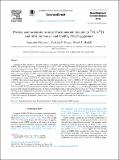Files in this item
Precise and accurate isotope fractionation factors (α17O, α18O and αD) for water and CaSO4·2H2O (gypsum)
Item metadata
| dc.contributor.author | Gázquez, Fernando | |
| dc.contributor.author | Evans, Nicholas P. | |
| dc.contributor.author | Hodell, David A. | |
| dc.date.accessioned | 2017-09-04T10:30:14Z | |
| dc.date.available | 2017-09-04T10:30:14Z | |
| dc.date.issued | 2017-02-01 | |
| dc.identifier | 250993847 | |
| dc.identifier | 1e30c346-c689-44a3-8b8a-8ec1ff33ba8a | |
| dc.identifier | 85007308625 | |
| dc.identifier.citation | Gázquez , F , Evans , N P & Hodell , D A 2017 , ' Precise and accurate isotope fractionation factors (α 17 O, α 18 O and αD) for water and CaSO 4 ·2H 2 O (gypsum) ' , Geochimica et Cosmochimica Acta , vol. 198 , pp. 259-270 . https://doi.org/10.1016/j.gca.2016.11.001 | en |
| dc.identifier.issn | 0016-7037 | |
| dc.identifier.uri | https://hdl.handle.net/10023/11608 | |
| dc.description | This research was supported by the ERC WIHM Project [#339694] to DAH. | en |
| dc.description.abstract | Gypsum (CaSO4·2H2O) is a hydrated mineral containing crystallization water, also known as gypsum hydration water (GHW). We determined isotope fractionation factors (α17O, α18O and αD) between GHW and free water of the mother solution in the temperature range from 3 °C to 55 °C at different salinities and precipitation rates. The hydrogen isotope fractionation factor (αDgypsum-water) increases by 0.0001 units per °C between 3 °C and 55 °C and salinities <150 g/L of NaCl. The αDgypsum-water is 0.9812 ± 0.0007 at 20 °C, which is in good agreement with previous estimates of 0.981 ± 0.001 at the same temperature. The α18Ogypsum-water slightly decreases with temperature by 0.00001 per °C, which is not significant over much of the temperature range considered for paleoclimate applications. Between 3 °C and 55 °C, α18Ogypsum-water averages 1.0035 ± 0.0002. This value is more precise than that reported previously (e.g. 1.0041 ± 0.0004 at 25 °C) and lower than the commonly accepted value of 1.004. We found that NaCl concentrations below 150 g/L do not significantly affect α18Ogypsum-water, but αDgypsum-water increases linearly with NaCl concentrations even at relatively low salinities, suggesting a salt correction is necessary for gypsum formed from brines. Unlike oxygen isotopes, the αDgypsum-water is affected by kinetic effects that increase with gypsum precipitation rate. As expected, the relationship of the fractionation factors for 17O and 18O follows the theoretical mass-dependent fractionation on Earth (θ = 0.529 ± 0.001). We provide specific examples of the importance of using the revised fractionation factors when calculating the isotopic composition of the fluids. | |
| dc.format.extent | 1326766 | |
| dc.language.iso | eng | |
| dc.relation.ispartof | Geochimica et Cosmochimica Acta | en |
| dc.subject | Gypsum hydration water | en |
| dc.subject | Fractionation factor | en |
| dc.subject | Triple oxygen isotopes | en |
| dc.subject | Stable isotopes | en |
| dc.subject | GE Environmental Sciences | en |
| dc.subject | QE Geology | en |
| dc.subject | DAS | en |
| dc.subject.lcc | GE | en |
| dc.subject.lcc | QE | en |
| dc.title | Precise and accurate isotope fractionation factors (α17O, α18O and αD) for water and CaSO4·2H2O (gypsum) | en |
| dc.type | Journal article | en |
| dc.contributor.institution | University of St Andrews. School of Earth & Environmental Sciences | en |
| dc.identifier.doi | 10.1016/j.gca.2016.11.001 | |
| dc.description.status | Peer reviewed | en |
| dc.identifier.url | http://www.sciencedirect.com/science/article/pii/S001670371630638X#s0095 | en |
This item appears in the following Collection(s)
Items in the St Andrews Research Repository are protected by copyright, with all rights reserved, unless otherwise indicated.

